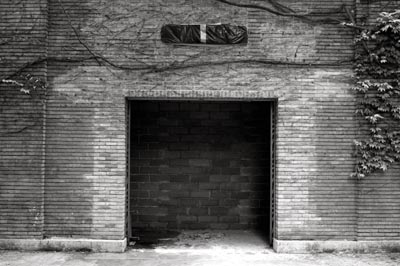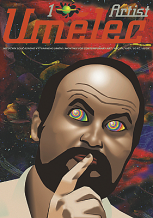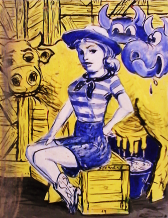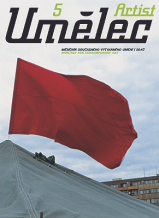| Umělec magazine 2003/1 >> Oil and Courage or Only to the edge of the 50th biennial festival of contemporary art in Venice | List of all editions. | ||||||||||||
|
|||||||||||||
Oil and Courage or Only to the edge of the 50th biennial festival of contemporary art in VeniceUmělec magazine 2003/101.01.2003 Marek Pokorný | venice biennale | en cs |
|||||||||||||
|
"“The moon shines nowhere as sweetly and as dreamily as it does in Venice.”
Jan Neruda The Venice Biennial is still the only exhibition of contemporary world art in which — unlike Sao Paolo, Istanbul, Quangzhu or Lyon and Valencia — Czech art critics not only regularly take part, but to which they regularly (albeit with doubtful success) refer. The Venice Biennial is accessible for us not only geographically but also mentally — it has its constants, and after such a long time it also has a certain familiarity, and certainly it has its charms. Moreover, from an ostensibly confusing amount of artistic positions and curators’ intentions there always finally emerges a clear structure in toto: we can carry away an impression from the national representations (and thus — we must stress — examples of art anchored in a certain national context) and even an impression from the exhibition organized by the main curator (lately not only in the Italian pavilion but also in the wide-ranging complex of the local arsenal and rope-walk). And, by the way, while we are talking about charms, this year these are maybe like the “neben effect,” my overall interpretation noted the Virtual Museum of Contemporary Art by Roman Ondák as part of the Utopia Station section at the end of the pier at the Corderie: benches with a view of the Canal, Sansovin’s architecture and visitors exhausted by the heat. As another representative of contemporary Slovak art, Július Koller is also in the same section and after a long time an artist from the Czech Republic, this time Pavel Mrkus, was nominated in the exhibition outside the Giardini. If the Venice Biennial provides not only an abundance of sensory stimuli, but also a whole range of matter-of-fact circumstantial evidence, it is possible to infer many things from its foundations about the strategic and unconscious — or rather uncontrollable — movements of the contemporary art scene in world terms, themes other Czech reflexes do not devote any, let alone enough, attention to. And so we have our first comparison at hand, although the Venice Biennial makes up for such critical reflexes by its pleasant business. The main curator this year — for the second time in the short jubilee period — (while in 1995 they celebrated one hundred years since its founding, now the Biennial is taking place for the fiftieth time) Francesco Bonami, an Italian with experience in America and an undoubted managerial dexterity, “gave up” the usual right of his predecessors to a curator’s one-man show, and he split the exhibition project accompanying national presentations with other significant personalities. The Arsenal and the Corderie therefore incorporated a further seven feelers as well as Bonami’s exhibition Clandestini; Gilane Towardos (Fault Lines, contemporary art from Africa), Igor Zabel (Individual Systems), Hou Hanru (Z.O.U. — Zone of Urgency), Carlos Basualdo (The Structure of Survival), Cathrin David (Contemporary Arab Representations), Gabriel Orozco (The Everyday Altered) and the trio Molly Nesbit, Hans Ulrich Obrist and Rirkrit Tiravanija (Utopia Station) were installed in the body of contemporary art. Of course it is quite fundamental that this gesture of Bonami’s has established on the international scene a further generation of curators between the ages of thirty-five and fifty, who will be representative after Szeeman, Hoet, Fuchs and other influential figures established in the 70s. Each individual section brings forward remarkable wholes and also single parts, and altogether it was possible to estimate ahead of time which direction each curator would take. In short it is not possible to repeat either the surprising Cities on the Move, or the fierce politicality of Document X or the discreet social metaphysics of Document 11. From my point of view, apart from the — in comparison with the overwhelming majority of presentations — the almost overlooked exhibition of Gabriel Orozco (and among the most intelligent work at the Biennial I include Orozco’s replica displayed in the arcade in front of the entrance to the administrative part of the Italian pavilion, which Carlo Scarpa had already projected and which, unheeded and almost destroyed, has lived through a series of effective spectacles), probably the most interesting piece was profiled by the curator Gilane Towardos with her remarkable attempt to introduce the creations of artists with African roots — from Egypt through Nigeria to South Africa. Despite the fact that the significant part of exhibited artists operate in America or in Europe, the exhibition was unequivocally dominated by work on the theme of the post-colonial reality of Africa in terms of culture, tradition and the problems of modernization in the dark continent. Fault Lines thus incorporated the presence of art in Africa, which two years ago rang out here very clearly — of course “only as” an attendant exhibition in one of the Venetian palaces — in the official setting, and therefore finally widened the discriminatory abilities of Europeans.When we talk about the composition of the “team” of curators, it is clear that gestures flow from Bonami: taking an interest in those who are younger or are to one side has finally gained a bolder outline, and on the pillars of this year’s Biennial it is at last possible to deploy a measurement corresponding to their institutional positions. Besides his “refugees,” Bonami also “tailored” the project Delays and Revolutions in co-operation with Daniel Birnbaum in the introduction to the Arsenal — in the area of the Italian pavilion in the Giardini and the chic exhibition Painting: From Rauschenberg to Murakami in the Correr Museum in the Piazza san Marco. According to the selection of co-operators and the distribution of themes his dexterity is clear, because the wide span revised the clarity of outline of the curators’ personalities and Bonami was left with free hands for the modeling of such a look for the Biennial so as to attract viewers and the market. If the obligatorily wide main theme reserved for national representatives this time was called Dreams and Conflicts — Dictatorship of the Viewer, exhibition projects shielded by Bonami always sunder it (either symmetrically or transitively) into two parts. If we want to be waspish, then dreams and conflicts should occur above all in the heads of the curators, which it did not seem to have done, according to the results. However radical and interesting and fecund and revelatory the individual projects are, they are only variations on that, which we do as our work today and every day. Dreams and conflicts are therefore left as no more than a good-looking logo and without meaning — as so often before. That is too little, unfortunately. With regard to the insecure status of the professional viewer and a stay at the Biennial during the days when no one other than “us” is moving here, I am restricted in my evaluations by the possible or actual reactions of interested amateurs, and it is difficult to judge to what extent it is a question of mere rhetorical figures or real problems. Only methodically and on the fringe: the viewer is, above all, the creation of that which he is looking at, and the conditions of his viewing, so that we learn something about the construction, about which it is supposed that it forms by its demands the institutional and mental frame of the artistic presentation. So we should start with this — why art is made something inferior to the regime that viewers are used to from elsewhere (advertising, fun, pop culture), therefore in the reflexes of interest in gallery institutions and the art market. In this way the viewer can not dictate, he is “only” — often willingly and magically — the victim of dictation, which Fredric Jammeson calls the cultural logic of late capitalism. After all, “dreams and conflicts” are the leitmotif of the Milanese Fondazione Sandretto Re Rebaudegno, whose artistic director is indeed Bonami (on the occasion of the Venice Biennial two years ago for that matter, Bonami issued a remarkable brochure Dreams, which was a collection of dreams from contemporary artists). Culture, logic and the market remained upheld.Because we have so far considered what the Venice Biennial offered originally as a bonus to its own nucleus of exhibitions, then we must look at the national pavilions in the Giardini. But not only because the emphasis of the organizers (including political pressure in the election of the main curator, which pressure tried to indiscriminately enforce the choice of the erstwhile secretary to the Italian minister of culture, art historian and enemy of contemporary creation Vittorio Sgarbi — his favorite was the controversial conservative Roger Hughes, a curator of Australian origin) is transferred here. Moreover this year the national pavilions with few exemptions do not offer particularly inspiring or unequivocally persuasive projects. This feeble standard, that is to say, can be found not only among the French (Jean-Marc Bustamante), but also among the Belgians, Japanese, Koreans, Austrians, Greeks and Swiss. It seems that this year’s politically correct and smartly overweening United States project is also very problematical, and the pavilion concept by the British star Chris Offil even tempts us to comment on manners which do not know which way to turn. The Russian pavilion does not lack uplift and interest, but it by no means runs to the cogency and radicalism that it showed in the first half of the 90s. From my standpoint, the complicated design for the Danish pavilion by Olafur Eliasson was also disappointing, since his formerly refined simple constructions have now acquired boldly realizable forms on the occasion of some world exhibitions. It is characteristic too, that just this year Martin Kippenberger finally won an honor since his design for the Venice metro stations was at last — posthumously — realized in the German pavilion. Candida Hofer’s cool, perfect photography of architecture, libraries and museums, also found a partner, who even post-mortem is able to puzzle everyone. If you stand in the middle of the main hall of the German pavilion on the metal grill of the metro ventilation shaft, from which a blast of air flows at intervals when the trains go by, it is impossible to think of anything other than If I could choose, then I would say that only the presentations from Spain, Israel, Serbia and Montenegro unequivocally communicate. By Venetian standards, Santiago Sierra radically reorganized the Spanish pavilion as an ironically critical memento of art as an autonomous and sublime institution by the way that it reminds us of the indefensible in the nation in the context of today’s world by excluding “non-Spanish viewers” from participating in the frustrating looting of the elegant pavilion. Israel is represented this time by the work of the artist Michal Rovner, who belongs (thanks also to her participation in the Whitney Biennial) more or less in the context of contemporary art in the United States. Her digital multiplication of electronic pictures, obsession with an “ornament” made up of human figures (this time very effectively screened in laboratory dishes as an exemplum vuiru) and endless loop of hopeless movement all have one and the same inviolable vanishing point: holocaust and genocide. An independent interpretation would be required by the concept of a Museum of Modern Art for the Serbo-Montenegran pavilion, which in fact dates from 1986, but nevertheless in the context of the blasé atmosphere of the Venice Biennial and the penetrative entries from other traditions balancing modernism, the modern and modernization (Africa, Mexico, Asia), it poses a fundamental question for the sense not only of the classification and determination of the main lines of Euro-Atlantic needs, but also as a commentary on contemporary reversals and revolutions, which do not often lack intelligence and sense, but more valid reasons. By a simple turn of the line of development added to mythical data on the origin of works, we get from Joseph Kossuth to Roy Lichtenstein and through Magritte to Duchamp and back to the contemporaries of Van Gogh and Matisse.My main memento of this year’s Venice Biennial is a picture by Rirktit Tiravanija in the section Delays and Revolutions, on which it is written: Less oil, more courage. Its commentary on painting or art persuasively echoes into the void, otherwise impossible at the moment when a dream and a conflict became a strategic category, and curators’ work becomes a parochial commodity, but after all only in a global market. If nothing else then, just this — far from naive but surely only perfectly disarming — the image holds on to sense and utopian individual urgency. Its challenge, even hopeless, whether to a greater or lesser degree, may actually be perceived as a question as to what courage is and on which side we approach its frontiers. The principle that certain offers cannot be refused, has today — it seems — a universal validity. Whoever of the artists and curators got to make this choice however, he has his regular work behind him, which, in the end, it is worth not refusing. And then there is the moon. That moon… "
01.01.2003
Recommended articles
|
|||||||||||||
|
04.02.2020 10:17
Letošní 50. ročník Art Basel přilákal celkem 93 000 návštěvníků a sběratelů z 80 zemí světa. 290 prémiových galerií představilo umělecká díla od počátku 20. století až po současnost. Hlavní sektor přehlídky, tradičně v prvním patře výstavního prostoru, představil 232 předních galerií z celého světa nabízející umění nejvyšší kvality. Veletrh ukázal vzestupný trend prodeje prostřednictvím galerií jak soukromým sbírkám, tak i institucím. Kromě hlavního veletrhu stály za návštěvu i ty přidružené: Volta, Liste a Photo Basel, k tomu doprovodné programy a výstavy v místních institucích, které kvalitou daleko přesahují hranice města tj. Kunsthalle Basel, Kunstmuseum, Tinguely muzeum nebo Fondation Beyeler.
|







































 New book by I.M.Jirous in English at our online bookshop.
New book by I.M.Jirous in English at our online bookshop.
Comments
There are currently no comments.Add new comment